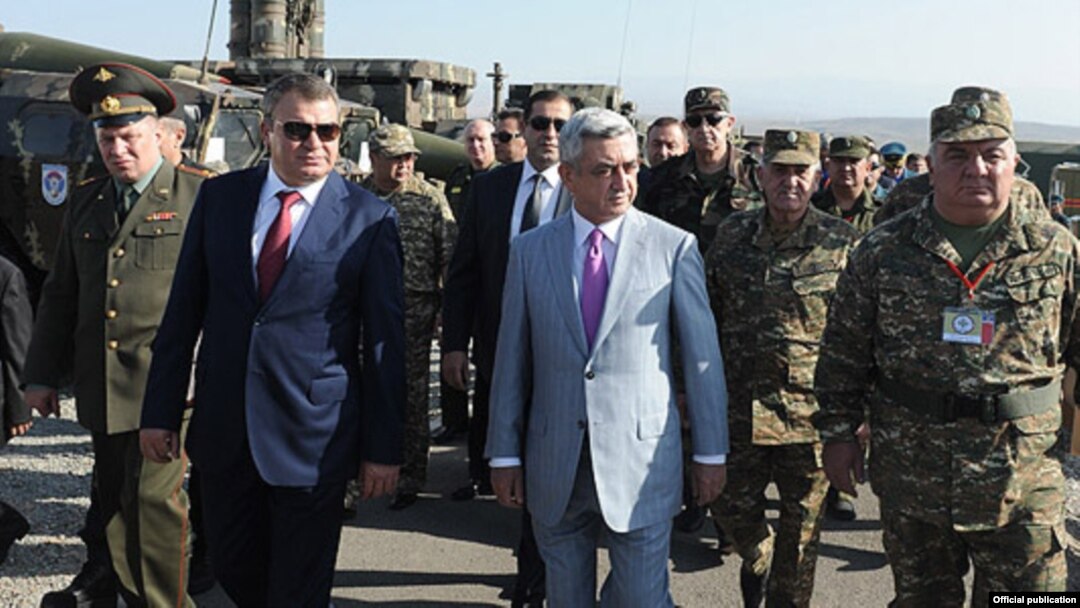Russian Defense Minister Anatoly Serdyukov emphasized the “strategic significance” of his country’s relations with Armenia after meeting Armenian leaders and watching military exercises held by the Russian-led Collective Security Treaty Organization (CSTO) near Yerevan on Wednesday.
Serdyukov joined President Serzh Sarkisian as well as his Armenian and Belarusian counterparts in monitoring the concluding phase of the five-day maneuvers held at the Armenian army’s Marshal Bagramian training ground. Kazakhstan’s top army general also arrived in Armenia on the occasion.

The drills also involved unmanned aircraft designed and manufactured in Armenia. The Krunk drones were first demonstrated by the Armenian military during a September 2011 parade in Yerevan.
Serdyukov praised the course of the war games when he held talks with Sarkisian later in the day. The Armenian president’s press office said they also discussed Russian-Armenian military ties and security “challenges” facing the region.
Serdyukov said Russian-Armenian relations are currently “at the highest level” and are strategically important to both nations after a separate meeting with Defense Minister Seyran Ohanian. The meeting focused on what the two men called a “reorganization” of Russian troops stationed in Armenia.
“We have had quite good meetings today during which we discussed a broad range of issues related to the 102nd Russian military base stationed in Armenia and its reorganization taking place within the framework of a reform of Russia’s Armed Forces,” Serdyukov told journalists.
The Russian minister appeared to refer to a redeployment of Russian army units in Armenia, which began in early 2011. In an apparently related development, the Russian military announced in June that it will double this year the number of its soldiers serving at the Soviet-era base headquartered in Gyumri on a contractual basis. It is still not clear if the total number of its military personnel will change as a result.
The Russian base is believed to have between 4,000 and 5,000 troops. It is equipped with hundreds of tanks, armored vehicles and artillery systems as well as sophisticated S-300 surface-to-air missiles and a squadron of MiG-29 fighter jets.
A Russian-Armenian agreement signed in 2010 extended the Russian military presence in the South Caucasus nation by 24 years, until 2044, and upgraded its security mission. It also committed the Russians to helping the Armenian military obtain “modern and compatible weaponry and (special) military hardware.”
Serdyukov joined President Serzh Sarkisian as well as his Armenian and Belarusian counterparts in monitoring the concluding phase of the five-day maneuvers held at the Armenian army’s Marshal Bagramian training ground. Kazakhstan’s top army general also arrived in Armenia on the occasion.

Armenia - Special forces from CSTO member states hold joint exercises at the Marshal Baghramian training center near Yerevan, 19Sep2012.
They looked on as about 2,000 soldiers from Armenia, Russia, Belarus, Kazakhstan, Kyrgyzstan and Tajikistan simulated a joint operation against imaginary “illegal armed formations” invading a CSTO member state. The CSTO troops were backed up by tanks, armored vehicles, artillery systems, helicopter gunships and warplanes firing live rounds.The drills also involved unmanned aircraft designed and manufactured in Armenia. The Krunk drones were first demonstrated by the Armenian military during a September 2011 parade in Yerevan.
Serdyukov praised the course of the war games when he held talks with Sarkisian later in the day. The Armenian president’s press office said they also discussed Russian-Armenian military ties and security “challenges” facing the region.
Serdyukov said Russian-Armenian relations are currently “at the highest level” and are strategically important to both nations after a separate meeting with Defense Minister Seyran Ohanian. The meeting focused on what the two men called a “reorganization” of Russian troops stationed in Armenia.
“We have had quite good meetings today during which we discussed a broad range of issues related to the 102nd Russian military base stationed in Armenia and its reorganization taking place within the framework of a reform of Russia’s Armed Forces,” Serdyukov told journalists.
Armenia - Explosions caused by heavy artillery fire during CSTO military exercises at the Marshal Bagramian training ground, 19Sep2012.
“We are transferring about 10 facilities to the Armenian side,” he said without elaborating. “We also discussed the issue of material-technical supplies to the base and our relationships in that regard.”The Russian minister appeared to refer to a redeployment of Russian army units in Armenia, which began in early 2011. In an apparently related development, the Russian military announced in June that it will double this year the number of its soldiers serving at the Soviet-era base headquartered in Gyumri on a contractual basis. It is still not clear if the total number of its military personnel will change as a result.
The Russian base is believed to have between 4,000 and 5,000 troops. It is equipped with hundreds of tanks, armored vehicles and artillery systems as well as sophisticated S-300 surface-to-air missiles and a squadron of MiG-29 fighter jets.
A Russian-Armenian agreement signed in 2010 extended the Russian military presence in the South Caucasus nation by 24 years, until 2044, and upgraded its security mission. It also committed the Russians to helping the Armenian military obtain “modern and compatible weaponry and (special) military hardware.”


